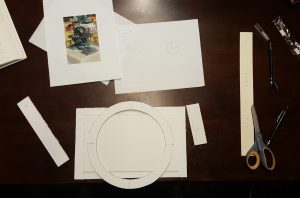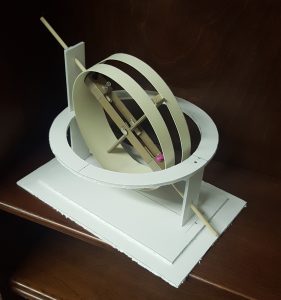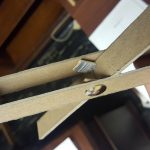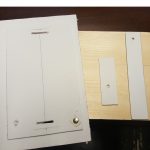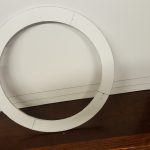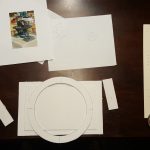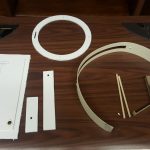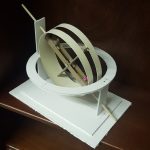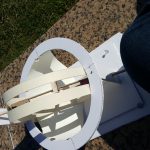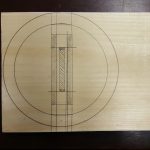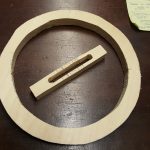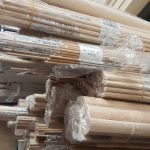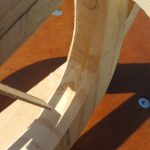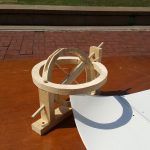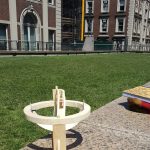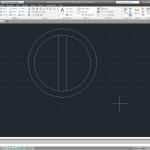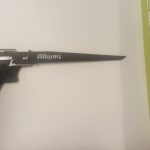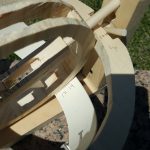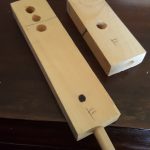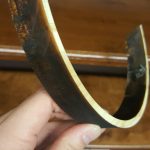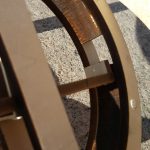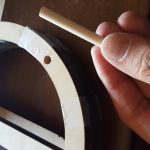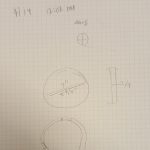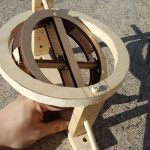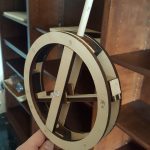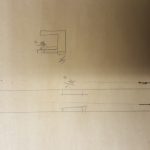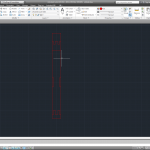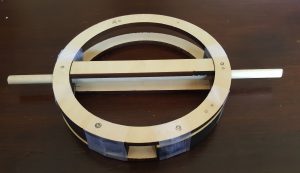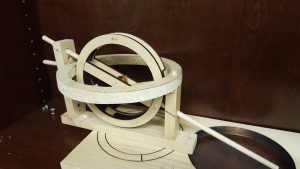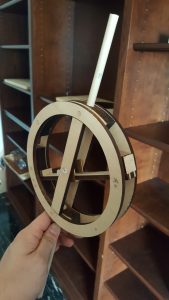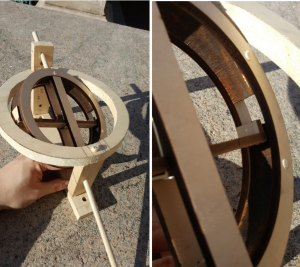by: Woohyun Tony Lee
Sejong Silok (The Annals of Choson Dynasty, Sejong Era) 77:10b (c. 1437) describes this instrument, South-Fixing Sundial. This instrument does not require having to use compass to determine direction of North. It captures image of the Sun through pinhole projection mechanism attached to pivoting alidade, and through that process automatically aligns self to latitude.
The source says that “15 of these were made, 10 in bronze…”. It does not indicate what the other 5 were made of – I assume wood. If for no other reason than any material other than bronze and wood does not make sense.
Reflection on your practice: The paper and foam materials I’m using allows me to manipulate them in ways that is not possible with wood. One of the advantages of bronze is that it is easy to shape. With wood and paper, the materials fight you to hold onto its shape, while bronze will shape into any mold you place it in.
Made the base – it is also the part aligns to latitude to tell north-south directions. 6” x 11”. With opening for pillars 8 3/4” apart.
And the north/south pillars, 9” and 6” high.
Fixed-Horizon Ring – The ring that connects the pillars. At first, this seemed to be most complicated but was actually easiest to make and probably the simplest part. 10” in radius.
Alidade: took most of the measuring and calculating at this stage. Had to think quite a bit in order to figure out how to fix the pivot and the opening for the strut. Case: 3⁄4” x 3⁄4” x 7 1⁄2”. Alidade: 7 1⁄2”.
Date: February 16th 2018
People Involved: Tony
Location: Kent Hall, Janoff’s Stationary, Home Depot
Environmental Conditions: Same empty room in Kent. Great since I can leave my stuff overnight.
Home Depot, at 3rd Avenue and 59th street. Big hassle to get here. Similar tinge of increased creative imagination as when you are in art supply store. But as a person who is used to gigantic hangar of Home Depots in Florida, disappointed by the sparse availability of materials, especially lumber here. But this location does have what I can work with.
Time and duration of experiments: A full night, spent measuring, fabricating, and mostly adjusting the parts to make the model work.
Equipment and tools used: X-acto knife, rulers, pins.
I avoided using glue or tapes. They add unnecessary mess, add weight and bulk, and easily fall apart with paper/foamboard.
Materials and their source and quantities: The papers actually had a distinctive advantage of being versatile enough to easily shape into rings – which will be extremely difficult to do with wood.
Wooden parts purchased: Pine hardwood bars: 1” x 12” x 1ft, pine dowels, 1/8 and 3/16 (to be used in wooden model and paper model as struts), balsawood panes: for thin strips to create alidade parts.
Subjective factors, e.g., how things smelled/tasted/looked/felt: The completed model puts forth an aura – it actually looks quite impressive, if I may so myself.
Prior knowledge that you have: I’m glad to have some experience working with 3D objects to create things. The level of comfort that I’ve had probably helped a great deal in moving quickly, by mostly knowing what I can’t do with these materials.
Reflection on your practice: Firstly, when making this instrument with wood, I need to make the inner, complicated parts first, then build the outer, relatively simpler parts. It is much more difficult to cut and shave the smaller, more delicate part with moving components.
While I was worried that I wouldn’t be able to make this object at all, it was not as problematic as I thought. Though I’m still worried since I’ve made many inferences and substitutes. But realizing that the core idea – pinhole projection, have no reason not to work.
Finished making the alidade. Used thumb tacks and push pins – quite handy and works well as a pivot.
Solar-declination ring made. The middle opening of the ring actually makes this part very difficult to fabricate and keep balance. 7 1⁄2” in diameter, but matboards do not hold circle shape.
Paper parts are pulled together and the prototype is completed.
Questions that arise:It is still unclear how I’m going to calculate and draw the notations on the equatorial half ring and fixed horizon ring. From my reading of the secondary sources, you will be able to tell the time of sunrise and sunset of the day using this instrument – though actually, this fact is not claimed on the primary source. It may be that the notations simply mark the degree of the solar ring. Nevertheless, I will attempt to find that out by working backwards – get the time of the sunrise/sunset from Google (or farmer’s almanac!) and record it into the instrument.
Date: February 27th 2018
People Involved: Tony
Location: Columbia Law School Lawn
Environmental Conditions: Exceptionally beautiful day. Almost no clouds, sun has a pleasant quality.
Time and duration of experiments: Between 1-2pm. My lunch break! Forces me to me more efficient with my time. This is actually my 2nd time using the paper model for measuring. The first was couple of days ago, from 12-1.
Equipment and tools used: The completed sundial. 3 different compass app hastily downloaded to make sure the sundial works as advertised.
Materials and their source and quantities: The sundial feels surprisingly not flimsy. The heavy matboard weighs down the foam and construction paper.
Subjective factors, e.g., how things smelled/tasted/looked/felt: Quite strange as I feel self-conscious about taking this silly looking sundial and fumbling around with it in public. But I actually get questions and compliment about it from acquaintances I run into.
While it wasn’t a warm day, thinking about sunlight, being directly exposed to it, and trying to manipulate makes me feel it more. It feels bright.
Prior knowledge that you have: Learned quite a bit about the Silok’s creation process. Court historiographers, who are present in all of official activities, records everything that is said and seen, including commentary by the historiographers. This first draft, called Sacho (史草), is then compiled when the king passes away and the next administration starts, and goes through 3 stages of editing. The final version is then published in several copies and stored in different locations throughout the country. At the end of the publication, the first draft is ceremonially washed in freshwater. The inks are washed away, but the Korean-papers (Hanji) is left intact, to be re-used for the first draft of the new administration. This result in vast amount of records, crucial firsthand data, being literally washed away. Personally, this means that the recipe for the South-fixing sundial was most certainly more robust and detailed, and I’m left to guess and figure out what the editors deemed not important enough or assume to be self-evident.
Reflection on your practice: The earlier attempt did not work properly, and I suspected that it was because I did not have the fixed equatorial half-ring. This time I learn that it wasn’t that – the projection mechanism should work without the ring. The ring is to have notations that tells what the time is by the degree of pivot of the solar ring.
I realize that it is working, but the sun does not project properly as the image of it is projected faintly, wide, and misaligned. Problem with the shoddy construction and improper measurements. But it is working. You can tell the instrument has to be aligned north to south in order for the projection to appear.
After reviewing the reconstruction manual, there is a formula for the size of pinhole. Will have to incorporate this when creating the wooden model.
Questions that arise:I wonder if the intended users of this instrument tried to figure it out as I did, and then another question occurred: do these objects create problems as much as solving them? Do these define phenomenon and materials in their terms, and then change our perception? And how did they learn to build these instruments in the first place?
Date: April 22nd
People Involved: Tony
Location: Makerspace, Collegewalk, Butler Library
Environmental Conditions: Even nicer day than yesterday. Perfect for measuring. But unfortunately spent mostly at Makerspace. Spent the morning at Butler for research since Kent and Makerspace does not open until noon. Makerspace is very busy with students. It seems there is a horde of architecture students scrambling to get their models ready. Space is messy and loud.
Time and duration of experiments: Measuring at 1:30pm, and 4:00pm. The measurements matches with the earlier 4pm notation. Rest of the day at Makerspace and Kent.
Equipment and tools used: Drill press, saws, laser cutter, and sundial.
Materials and their source and quantities: Pine/Bass/Balsa. About half of the wood materials I bought have turned into sawdust. I probably inhaled about half of those.
Subjective factors, e.g., how things smelled/tasted/looked/felt: The latest, laser-cut parts look half professional. Quite glad that I decided to jump onto using the laser cutter. The laser produces a handsome looking burns on the edges, giving it a distinctive look.
Prior knowledge that you have: After the umpteenth time reading the Needham text, finally realize that the notation on the fixed ring are for telling the directions after the sundial has fixed self toward the north, and nothing especially special like the direction of the constellations. After further investigation, they are notation of 24 radical directions characters that were used in China. As engraved in this Chinese compass.
Reflection on your practice: Getting quite comfortable in Makerspace. It’s a fun place to be.
I can tell that at this point, I got a lot better at fabricating these objects. I have went about this in a quite inefficient way – making, remaking, and then remaking again. Could more research prevented all the confusion and the problems during the recreation? Possibly. But it is also true that there is a distinct lack of sources and literature for this object. I know as I’ve looked.
Questions that arise: Where did the 24 directions notations come from? Does it have scientific roots? And how is it that this was disconnected from the literature of the 24 seasons and the astronomy? Perhaps it was present and I missed it because I was not aware of it as I didn’t know what it was.
